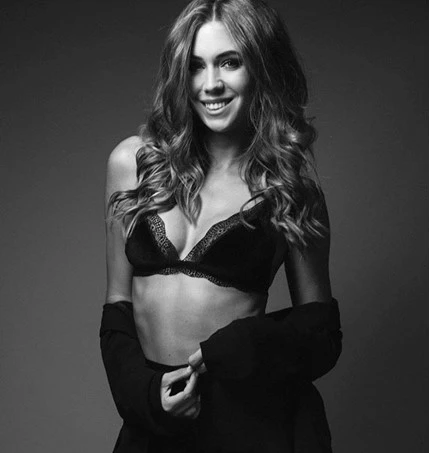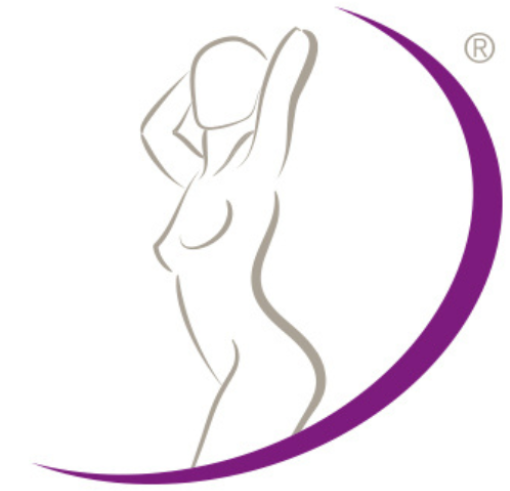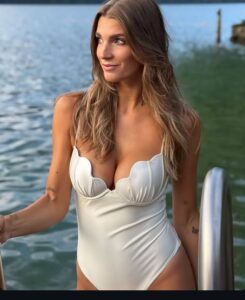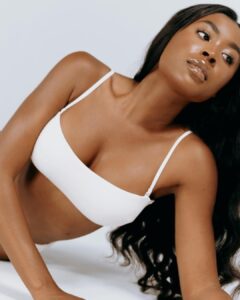- Confide in us
- Certified plastic surgeon
- 25 years of experience
- Quality over quantity
- Reliable aftercare
- Confide in us
- Certified plastic surgeon
- 25 years of experience
- Quality over quantity
- Reliable aftercare
What is a breast augmentation?
Do you dream of fuller, more feminine breasts and a naturally full décolleté?
Then consider breast augmentation, a surgical procedure in which we correct the size and shape of your breasts with silicone breast implants.
Breast augmentation with silicone implants is one of the most common and favorite procedures of plastic surgeon Dr. Nelissen, who has been an authority in Belgium for breast augmentation and breast lifts for 25 years.
With a trained eye for aesthetics, we strive for a natural and harmonious result, choosing the right breast implants that perfectly match your body in size and shape. In some cases, an additional breast lift may be performed for an even more attractive result.
On this page, we provide detailed information so you can make an informed decision about breast augmentation with silicone implants and/or a breast lift. Feel free to contact us for an extensive consultation and discover how we can guide you step by step to your desired look.
- We welcome you with:
- 25 years experience in breast augmentation and breast lift
- Extensive consultation, guidance and aftercare
- Natural results
- High-quality breast implants
- Small incision - minimal scar
- Pain-free and quick recovery
- General anesthesia in day clinic (home the same day)
- Safe high-tech operating theatre
- Dedicated team, nurses and anesthesist
- Good reviews and satisfaction
Facts about breast augmentation with silicone implants
What you definitely want to know about breast augmentation and breast implants:
- From €3630
- Procedure of 1 hour
- General anesthesia (anesthesiologist)
- Home the same day (day surgery)
- 3 days to 2 weeks recovery
- Minimal incision of approximately 3 cm beneath (in) the natural breast fold.
Why or when should you get a breast augmentation?
Feel feminine again with a breast augmentation
Maybe you recognize yourself in one of the following situations where women choose breast augmentation:
- Naturally small breasts.
- Volume loss and sagging breasts after pregnancy, breastfeeding, weight fluctuations, or aging.
- Sagging breasts, for which a breast lift, with or without breast implants, may be considered.
- Asymmetrical breasts, being a difference in size or shape between both breasts.
A breast augmentation often gives these women an instant boost in their self-esteem and confidence.
Is breast augmentation also interesting for you?
Safe breast augmentation with the latest silicone implants
A breast augmentation is a safe procedure performed on an outpatient basis under general anesthesia (by our regular anesthetist) in our state-of-the-art operating room with the latest generation of silicone implants.
In our private clinic in Belgium, we are happy to advise you extensively on all options for breast augmentation.
Which breast augmentation is right for me?
How do I choose the best breast implants?
First step is a comprehensive consultation where the plastic surgeon assesses your expectations, taking into account your body structure, the shape and size of your current breasts, and your personal situation (what is your age, are you already a mother, do you still want children,…).
The ideal breast implant for you will then be determined based on:
- Measurements of the current situation.
- Fitting of different implants.
- Viewing before-and-after photos of breast augmentations.
- A possible Crisalix 3D visualization.
New: what is Preservé breast augmentation?
New standard in breast surgery
Preservé is a revolutionary breast augmentation technique performed through a small 2.5 cm incision in the natural breast fold.
The technique was developed with the goal of minimizing damage to the breast tissue. You can resume your daily activities almost immediately, as no muscles, nerves, or blood vessels are cut when creating the pocket for the implant.
The Preservé method is a breast-conserving procedure that is safe, gentle, tissue-friendly, and also reduces the risk of loss of sensation in the nipples.
Choose the Preservé technique if:
- You want to return to your family or work on the same day.
- You want to avoid taking sick leave or prefer to keep the procedure private.
- You prefer breast-conserving surgery where no muscles, nerves, or blood vessels are cut.
- You do not want to lose sensation in your nipples.
- You want to keep all options for breastfeeding open.
- You want to resume sports activities after 3 weeks.
- You want the smallest possible scar in the breast fold, 2.5 cm.
- You want a breast augmentation that looks natural and is proportional to your body.
- You want lightweight Motiva implants, feeling like real breasts.
- You want to restore the shape of your breasts after breastfeeding or weight loss.
- You want to take as little pain medication as possible, only 1–2 days.
- You want the smallest possible risk of infection and capsule formation.
- You want 5 years of warranty against all implant-related complications.
How much does a breast augmentation with silicone implants cost?
In addition to the best facilities and the most experience, we also offer the highest-quality silicone implants for a top result. Our price for breast augmentation starts from €3630.
After your consultation, you will receive a personalized all-inclusive price offer. Click here to see all breast augmentation prices and what is included in our price.
Before and after photos breast augmentation
Click here to view the before-and-after photos of breast augmentation with real patient results. During the consultation, we can show you even more examples, carefully selected for you, and provide detailed information about the implants used.
FAQ – Frequently asked questions about breast augmentation and breast implants
What is the Preservé breast augmentation?
Will my breasts still feel and look natural?
Will my breasts look fake? Will the implant be visible when I lie down? Will I feel the implant? Will the breast implant feel hard? Will everyone notice that I had a breast augmentation?
Read here for more information on how we create the most natural possible result in our breast augmentations (question 6).
Do I also need a breast lift?
Breast lift or breast augmentation, or both? A common question from patients considering breast augmentation is whether they also need a breast lift. Read here for more information on when a breast lift with or without implants may be recommended.
What does the scar look like after a breast augmentation?
Where is the scar or incision located during a breast augmentation? What does the scar look like? Will the scar be noticeable? Is there anything I can do to promote healing?
Read further here for answers to questions about where the scar from a breast augmentation will be and what it will look like (Questions 4 + 5).
Will I have a lot of pain after a breast augmentation?
For Dr. Nelissen’s patients, the pain is usually exceptionally manageable, thanks to the careful selection of implants, the surgical technique, and effective pain management.
Read here everything about how much pain and how long it lasts after breast augmentation (question 3).
Which size or shape of breast implant is right for me? How many cc? What cup size?
We often receive the first question or comment as: “I would like so many cc” or “I want a bra size of so and so.”
During the consultation, we aim to translate these wishes into an implant size, shape, and profile that fit the patient.
Read here how we help you to choose the number of cc for your breast implants (question 2).
Why is breast augmentation the most performed surgery at Global Care Clinic?
- More than 25 years of experience with breast augmentation and breast lift
- Safe, high-quality breast implants with a natural look and feel
- Smaller incision with minimal scar
- Faster recovery and pain-free awakening after general anesthesia
- No waiting lists (own operating room)
Satisfied breast augmentation experiences

And then the most important part: the result. It turned out so beautifully! I finally feel like a woman, and I didn’t even have to suffer for it. No pain at all… I am a very happy patient and definitely recommend this clinic! Here, you are not just a number but a person – and that is very important to me.

Happy! That is the first word that comes to mind after my breast augmentation. Not only because I am extremely happy with the result, but with the whole experience. The first consultation was exciting! With sweaty hands and a lot of nerves, I walked into the clinic. But thanks to the homely atmosphere and the incredibly warm welcome, my nerves disappeared like snow in the sun.

A very pleasant experience. The reception at this clinic is very warm. You immediately feel at ease and are personally accompanied to the operating room on the day of surgery. The follow-up appointments are also organized very efficiently. Global Care Clinic has an incredibly nice and competent team. Even in the first days after the surgery, I hardly had any discomfort. Once again, I am very satisfied with the result!
Video testimonials
Watch the video testimonials of Céline, Talisa Loup and other patients here to see why they choose breast augmentation at the Global Care Clinic.

Your breast augmentation
-step by step-
Step 1:
Schedule an appointment
You start your journey by scheduling an appointment. This can be done through our online system or by giving us a call, sending an email, or filling out the contact or callback form.
Step 2:
Your consultation
Time to get acquainted. On the day of your appointment, you will meet plastic surgeon Dr. Nelissen, our dedicated team, and our private clinic.
Step 3:
Schedule surgery
Read all information here about booking your surgery, the waiting times,…
Step 4:
Preparation for surgery
Read all the information about how to prepare for your surgery.
Step 5:
Surgery day
Read all the information here about the course of your surgery day. Where will the surgery take place? When can you go home?
Step 6:
Recovery from your surgery
Read here all the information about how your recovery after surgery goes and the potential risks and complications.
Frequently Asked Questions
FAQ
Read here the frequently asked general questions about plastic surgery and operations.
Watch a breast augmentation surgery
Click here for a 3D animation video of a breast augmentation, developed by the American Society for Plastic Surgeons:
Take a look inside our operating room

Make your appointment
Easily book your appointment by giving us a call, sending an email, or using our contact or callback form.
For consultations and anti-wrinkle injections, you can also book an appointment online to see available time slots directly.





